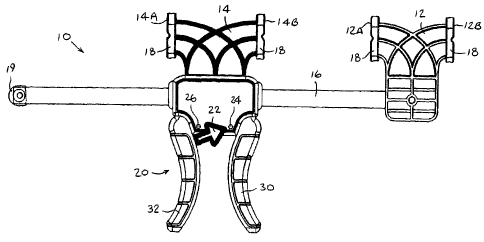Some of the information on this Web page has been provided by external sources. The Government of Canada is not responsible for the accuracy, reliability or currency of the information supplied by external sources. Users wishing to rely upon this information should consult directly with the source of the information. Content provided by external sources is not subject to official languages, privacy and accessibility requirements.
Any discrepancies in the text and image of the Claims and Abstract are due to differing posting times. Text of the Claims and Abstract are posted:
| (12) Patent: | (11) CA 2503459 |
|---|---|
| (54) English Title: | BAR CLAMP |
| (54) French Title: | BRIDE DE SERRAGE |
| Status: | Deemed expired |
| (51) International Patent Classification (IPC): |
|
|---|---|
| (72) Inventors : |
|
| (73) Owners : |
|
| (71) Applicants : |
|
| (74) Agent: | BULL, HOUSSER & TUPPER LLP |
| (74) Associate agent: | |
| (45) Issued: | 2010-06-01 |
| (86) PCT Filing Date: | 2003-07-22 |
| (87) Open to Public Inspection: | 2004-01-29 |
| Examination requested: | 2007-08-08 |
| Availability of licence: | N/A |
| (25) Language of filing: | English |
| Patent Cooperation Treaty (PCT): | Yes |
|---|---|
| (86) PCT Filing Number: | PCT/IL2003/000601 |
| (87) International Publication Number: | WO2004/009294 |
| (85) National Entry: | 2005-01-21 |
| (30) Application Priority Data: | ||||||
|---|---|---|---|---|---|---|
|
A bar clamp (10) comprising a bar (16), a fist clamping jaw (12) mounted on
the bar, a second clamping jaw (14) slidingly mounted on the bar, at least one
of the clamping jaws (12, 14) comprising a double-faced clamping jaw (12A,
12B, 14A, 14B) comprising one face facing one end of the bar and another face
facing an opposite end of the bar, wherein centers of both faces of the double-
faced clamping jaw are positioned at substantially equal heights from the bar,
and a jaw advancing mechanism (20) coupled to the second clamping jaw (14) and
adapted to move the second clamping jaw (14) selectively towards or away from
the first clamping jaw (12).
L'invention concerne une bride de serrage (10) comprenant une barre (16), une première griffe de serrage (12) montée sur la barre, une seconde griffe de serrage (14) montée par glissement sur la barre, au moins une des griffes de serrage (12, 14) comprenant un griffe de serrage à double face (12A, 12B, 14A, 14B) comportant une face en regard d'une extrémité de la barre et une autre face en regard de l'extrémité opposée de la barre. Les centres des deux faces de la griffe de serrage à double face sont placés à des hauteurs sensiblement égales éloignées de la barre et un mécanisme (20) d'avancement de la griffe est couplé à la seconde griffe de serrage (14) et conçu pour rapprocher la seconde griffe de serrage (14) de manière sélective ou l'éloigner de la première griffe de serrage (12).
Note: Claims are shown in the official language in which they were submitted.
Note: Descriptions are shown in the official language in which they were submitted.

For a clearer understanding of the status of the application/patent presented on this page, the site Disclaimer , as well as the definitions for Patent , Administrative Status , Maintenance Fee and Payment History should be consulted.
| Title | Date |
|---|---|
| Forecasted Issue Date | 2010-06-01 |
| (86) PCT Filing Date | 2003-07-22 |
| (87) PCT Publication Date | 2004-01-29 |
| (85) National Entry | 2005-01-21 |
| Examination Requested | 2007-08-08 |
| (45) Issued | 2010-06-01 |
| Deemed Expired | 2016-07-22 |
There is no abandonment history.
| Fee Type | Anniversary Year | Due Date | Amount Paid | Paid Date |
|---|---|---|---|---|
| Application Fee | $400.00 | 2005-01-21 | ||
| Registration of a document - section 124 | $100.00 | 2005-04-28 | ||
| Registration of a document - section 124 | $100.00 | 2005-04-28 | ||
| Maintenance Fee - Application - New Act | 2 | 2005-07-22 | $100.00 | 2005-07-19 |
| Maintenance Fee - Application - New Act | 3 | 2006-07-24 | $100.00 | 2006-05-24 |
| Maintenance Fee - Application - New Act | 4 | 2007-07-23 | $100.00 | 2007-05-09 |
| Request for Examination | $800.00 | 2007-08-08 | ||
| Maintenance Fee - Application - New Act | 5 | 2008-07-22 | $200.00 | 2008-06-25 |
| Maintenance Fee - Application - New Act | 6 | 2009-07-22 | $200.00 | 2009-04-30 |
| Final Fee | $300.00 | 2010-03-16 | ||
| Maintenance Fee - Application - New Act | 7 | 2010-07-22 | $200.00 | 2010-04-28 |
| Maintenance Fee - Patent - New Act | 8 | 2011-07-22 | $200.00 | 2011-05-13 |
| Maintenance Fee - Patent - New Act | 9 | 2012-07-23 | $200.00 | 2012-05-10 |
| Maintenance Fee - Patent - New Act | 10 | 2013-07-22 | $250.00 | 2013-07-18 |
| Maintenance Fee - Patent - New Act | 11 | 2014-07-22 | $250.00 | 2014-05-02 |
Note: Records showing the ownership history in alphabetical order.
| Current Owners on Record |
|---|
| TEFENPLAST (KIRUR) LTD. |
| Past Owners on Record |
|---|
| BEN-GIGI, ZION |